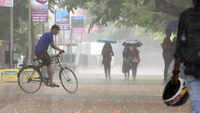
On World Environment Day (theme: Air Pollution), senior principal scientist at the National Environmental Engineering Research Institute (Neeri) Padma Rao, who heads the Air Pollution Control Division since the last seven years, presents a road map for policymakers in an exclusive with TOI.
Excerpts from the interview...
What are the primary sources of air pollution? Are there any which are still under wraps despite being major contributors?
Combustion activities are the major contributors to air pollution, be it in households, industries or transport sector. Wherever you use energy, air pollution will occur. To overcome it, air needs to be perceived as a resource and get quantified for judicial use. Non-combustible activities like construction and re-suspended dust particles emitted from moving vehicles are two main underestimated contributors.
The government recently launched the National Clean Air Programme (NCAP). In your view, does it cover all key aspects to abate air pollution?
It’s a very ambitious programme and can be implemented in a holistic way by incorporating all the stakeholders. While it is focusing more on ambient air quality monitoring systems and their certification, we also need to prioritize implementation of action plans on ground. For instance, take construction. Despite having many norms, the same are not being implemented nor regulated. Also, better air pollution control mechanisms for industries need to be introduced at technology level. Most importantly, the part of emission inventory needs to be strengthened. It is essential to update emission inventory every 2.5 years. NCAP should also regulate a mandatory green belt in cities.
Is green cover significant in curbing air pollution?
While wind, temperature, rainfall and humidity help in dilution and dispersion of air pollution, trees help in mitigation. Traditional tree species like banyan, Neem and peepal have good foliage area and absorb pollution. NCAP should have a set target for tree population.
What about pollution from transport sector which is a common problem in most urban areas?
Under NCAP, sustainable transport should be another focus area. If mass transit systems are being introduced in cities, the awareness about the same should be percolated among citizens to bring about a change in mindset. We should also look at modifications in existing vehicles like e-taxis. Even an autorickshaw can be effectively modified to a less polluting unit by operating it through battery. Vehicle maintenance for a better air-fuel ratio is a must.
Is the ambient air quality monitoring carried out by state pollution control boards accurate and effective?
Whether manual or real-time, both monitoring types have its own limitations. They need stringent calibrations and certifications. However, we need to keep in mind that monitoring is diagnosis of the problem. The stress on accuracy of the monitoring system is essential. But since most of our cities are non-compliant, we need to put in more research and resources on controlling pollution. Our atmosphere is becoming sick and we can’t go on diagnosing it.
Are we taking stringent steps to punish the polluters?
The National Green Tribunal, Central Pollution Control Board and state boards are taking care of it. Though some delays are there, they are taking cognisance of the fact that pollution control is important as it is affecting the health of population. We are taking the problem seriously.
Government has denied international studies highlighting high mortality rate in India due to pollution?
Most international organizations depend more on satellite data which needs lot of corrections. Some studies are short-term too. While some Indian institutes have fixed-up linkages between mortality and air pollution, we need more clinical and epidemiological studies.
Excerpts from the interview...
What are the primary sources of air pollution? Are there any which are still under wraps despite being major contributors?
Combustion activities are the major contributors to air pollution, be it in households, industries or transport sector. Wherever you use energy, air pollution will occur. To overcome it, air needs to be perceived as a resource and get quantified for judicial use. Non-combustible activities like construction and re-suspended dust particles emitted from moving vehicles are two main underestimated contributors.
The government recently launched the National Clean Air Programme (NCAP). In your view, does it cover all key aspects to abate air pollution?
It’s a very ambitious programme and can be implemented in a holistic way by incorporating all the stakeholders. While it is focusing more on ambient air quality monitoring systems and their certification, we also need to prioritize implementation of action plans on ground. For instance, take construction. Despite having many norms, the same are not being implemented nor regulated. Also, better air pollution control mechanisms for industries need to be introduced at technology level. Most importantly, the part of emission inventory needs to be strengthened. It is essential to update emission inventory every 2.5 years. NCAP should also regulate a mandatory green belt in cities.
Is green cover significant in curbing air pollution?
While wind, temperature, rainfall and humidity help in dilution and dispersion of air pollution, trees help in mitigation. Traditional tree species like banyan, Neem and peepal have good foliage area and absorb pollution. NCAP should have a set target for tree population.
What about pollution from transport sector which is a common problem in most urban areas?
Under NCAP, sustainable transport should be another focus area. If mass transit systems are being introduced in cities, the awareness about the same should be percolated among citizens to bring about a change in mindset. We should also look at modifications in existing vehicles like e-taxis. Even an autorickshaw can be effectively modified to a less polluting unit by operating it through battery. Vehicle maintenance for a better air-fuel ratio is a must.
Is the ambient air quality monitoring carried out by state pollution control boards accurate and effective?
Whether manual or real-time, both monitoring types have its own limitations. They need stringent calibrations and certifications. However, we need to keep in mind that monitoring is diagnosis of the problem. The stress on accuracy of the monitoring system is essential. But since most of our cities are non-compliant, we need to put in more research and resources on controlling pollution. Our atmosphere is becoming sick and we can’t go on diagnosing it.
Are we taking stringent steps to punish the polluters?
The National Green Tribunal, Central Pollution Control Board and state boards are taking care of it. Though some delays are there, they are taking cognisance of the fact that pollution control is important as it is affecting the health of population. We are taking the problem seriously.
Government has denied international studies highlighting high mortality rate in India due to pollution?
Most international organizations depend more on satellite data which needs lot of corrections. Some studies are short-term too. While some Indian institutes have fixed-up linkages between mortality and air pollution, we need more clinical and epidemiological studies.
World Cup 2019
Trending Topics
LATEST VIDEOS
More from TOI
Navbharat Times
Featured Today in Travel
Quick Links
Lok Sabha Election Schedule 2019Lok Sabha Election NewsDelhi Capitals teamMI team 2019Rajasthan Royals 2019RCB team 2019Maharashtra Lok Sabha ConstituenciesBJP Candidate ListBJP List 2019 TamilnaduShiv Sena List 2019AP BJP List 2019Mamata BanerjeeBJP List 2019 MaharashtraPriyanka GandhiBJP List 2019 KarnatakaAMMK Candidate List 2019BJP List 2019 WBLok Sabha Elections in Tamil NaduBSP List 2019 UPNews in TamilLok Sabha Poll 2019Satta Matka 2018PM ModiMahagathbandhanNagpur BJP Candidate ListChandrababu NaiduTamil Nadu ElectionsUrmila MatondkarNews in TeluguMadras High CourtTejashwi YadavArvind KejriwalTejasvi SuryaPawan KalyanArvind KejriwalYogi AdityanathJaya PradaSatta King 2019Srinagar encounter
Get the app







